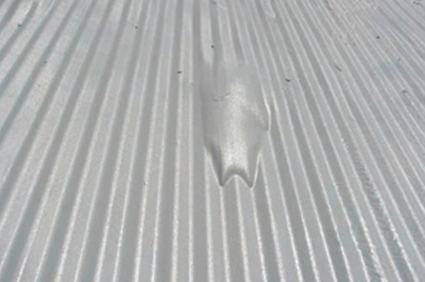Blister & Pinhole Troubleshooting
When applying fast set coatings the cause of blisters and pinholes can be difficult to diagnose. You may spray the coating system for an extended period of time and never experience a blister or pinhole. Then suddenly on the very next job blisters or pinholes may appear. In this article we hope to give a better understanding of the reasons blisters and pinholes occur.
Moisture Blistering
Moisture blisters are probably the most common form of blisters applicators will experience. Moisture blisters are a result of excess moisture reacting with the isocyanate component of the coating system. This type of blistering may not show up until 6 to 18 hours after the spray application. This can be caused by applying the coating in high humidity, or excessive moisture in the compressed air lines to the spray gun.
While it is true that the polyurea systems are not as sensitive to moisture during application like polyurethane systems, polyurea can be affected by moisture if there is an off ratio application (iso rich) or isocyanate is spitting or leaking in the spray gun.

Thermal Blistering / Delamination
Thermal blisters form between of the coats or layers of the spray application. These blisters generally occur when a coating is applied to a cold surface. The initial pass or layer cures slower due to the heat sink effect of the cold substrate. The initial coat acts as an insulator and the second coat cures faster which results in stress shrinkage being applied to the first coat that is softer from the slower curing resulting in blister formation.
Thermal blisters can also be caused by excessive heat or exotherm buildup within the layers of the spray application. This causes the next layer to cure to rapidly not allowing it to wet out and no bonding action occurs and delamination will be the result.
An advantage of polyurea coatings is their high thermal stability compared to polyurethane coatings.
Pinholes
Pinholes are generally caused by moisture that is trapped in the substrate being coated. The heat generated by the exothermic reaction of the coating causes the moisture trapped in the substrate to expand and push its way up through the still uncured coating (often referred to as outgassing) resulting in pinholes or blisters. You can experience the same thing if spraying over primer that has not fully cured.
Blister Characterization
If you have experienced blisters during the coating application you will need to determine what type of blisters you have before the problem can be addressed. The only way to do this is to cut a blister open and examine the section.
General guideline to troubleshooting the blister problem
- If the backside of the blister is smooth the blister is generally caused by contamination of the substrate or moisture/ trapped gas in the substrate.
- If the backside of the blister is rough or furry looking, the blister is generally caused by moisture reacting with the coating during the curing process or an off ratio (iso rich) application.
- If the backside of the blister is gummy the blister is generally caused by spraying over primer that has not fully cured or an off ratio (resin rich) application.



